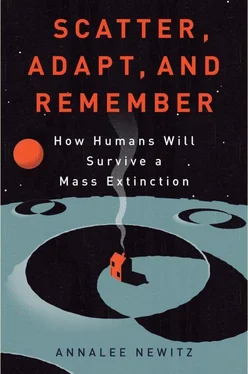7. MEETING THE NEANDERTHALS
NEANDERTHALS WERE HUMANS who went extinct between 20,000 and 30,000 years ago. Though there is some debate about who these people were, there is no question that there are none left. All that remains of the hundreds of Neanderthal groups that roved across Europe and Central Asia are a handful of ambiguous funeral sites, bones, tools, and pieces of art—along with some DNA that modern humans inherited from them. How can we avoid meeting the Neanderthals’ fate? That depends on what you think wiped out these early humans in the millennia after they met H. sapiens .
By 40,000 years ago, humans had spread in waves across most of the world, from Africa to Europe, Asia, and even Australia. But these humans were not all perfectly alike. When some groups of H. sapiens poured out of Africa, they walked north, then west. In this thickly forested land, they came face-to-face with other humans, stockier and lighter skinned than themselves, who had been living for thousands of years in the cold wilds of Europe, Russia, and Central Asia. Today we call these humans Neanderthals, a name derived from the Neander Valley caves in Germany where the first Neanderthal skull was identified in the nineteenth century.
Neanderthals were not one unified group. They had spread far enough across Europe, Asia, and the Middle East that they formed regional groups, something like modern human tribes or races, who probably looked fairly different from each other. Neanderthals used tools and fire, just as H. sapiens did, and the different Neanderthal groups probably had a variety of languages and cultural traditions. But in many ways they were dramatically unlike H. sapiens, leading isolated lives in small bands of 10 to 15 people, with few resources. They had several tools, including spears for hunting and sharpened flints for scraping hides, cutting meat, and cracking bones. Unlike H. sapiens, who ate a wide range of vegetables and meat, Neanderthals were mostly meat-eaters who endured often horrifically difficult seasons with very little food. Still, there is evidence that they cared for each other through hardship: fossils retrieved from a cave in Iraq include the skeleton of a Neanderthal who had been terribly injured, with a smashed eye socket and severed arm, whose bones had nevertheless healed over time. Like humans today, these hominins nursed each other back to health after life-threatening injuries.
Roughly 10,000 years after their first meeting with H. sapiens, all the Neanderthal groups were extinct and H. sapiens was the dominant hominin on Earth. What happened during those millennia when H. sapiens lived alongside creatures who must have looked to them like humanoid aliens?
A few decades ago, most scientists would have answered that it was a nightmare. Stanford’s Richard Klein, who spent years in France comparing the tools of Neanderthals and early H. sapiens, lowered his voice a register when I recently asked him to describe the meeting between these hominin groups. “You don’t like to think about a holocaust, but it’s quite possible,” he said. He referred to the long-standing belief among many anthropologists that H. sapiens exterminated Neanderthals with superior weapons and intellect. For a long time, there seemed to be no other explanation for the rapid disappearance of Neanderthals after H. sapiens arrived in their territories.
Today, however, there is a growing body of evidence from the field of population genetics that tells a very different story about what happened when the two groups of early humans lived together, sharing the same caves and hearths. Anthropologists like Milford Wolpoff, of the University of Michigan, and John Hawks have suggested that the two groups formed a new, hybrid human culture. Instead of exterminating Neanderthals, their theory goes, H. sapiens had children with them until Neanderthals’ genetic uniqueness slowly dissolved into H. sapiens over the generations. This idea is supported by compelling evidence that modern humans carry Neanderthal genes in our DNA.
Regardless of whether H. sapiens murdered or married the Neanderthals they met in the frozen forests of Europe and Russia, the fact remains that our barrel-chested cousins no longer walk among us. They are a group of humans who went extinct. The story of how that happened is as much about survival as it is about destruction.
The Neanderthal Way of Life
We have only fragmentary evidence of what Neanderthal life was like before the arrival of H. sapiens . Though they would have looked different from H. sapiens, they were not another species. Some anthropologists call Neanderthals a “subspecies” to indicate their evolutionary divergence from us, but there is strong evidence that Neanderthals could and did interbreed with H. sapiens . Contrary to popular belief, Neanderthals probably weren’t swarthy; it’s likely that these early humans were pale-skinned, possibly with red hair. We know that they used their spears to hunt mammoths and other big game. Many Neanderthal skeletons are distorted by broken bones that healed, often crookedly; this suggests that they killed game in close combat with it, sustaining many injuries in the process. They struggled with dramatic climate changes too. The European and Asian climates swung between little ice ages and warmer periods during the height of Neanderthal life, and these temperature changes would have constantly pushed the Neanderthals out of familiar hunting grounds. Many of them took shelter from the weather in roomy caves overlooking forested valleys or coastal cliffs.
Though their range extended from Western Europe to Central Asia, the Neanderthal population was probably quite small—a generous estimate would put it at 100,000 individuals total at its apex, and many scientists believe it could have been under 10,000. By examining the growth of enamel on Neanderthal teeth, anthropologists have determined that many suffered periods of extreme hunger while they were young. This problem may have been exacerbated by their meat-heavy diets. When mammoth hunting didn’t go well, or a particularly cold season left their favored game skinny or sick, the Neanderthals would have gone through months of malnutrition. Though Neanderthals buried their dead, made tools, and (at least in one case) built houses out of mammoth bones, we have no traditional evidence that they had language or culture as we know them. Usually such evidence comes in the form of art or symbolic items left behind. Neanderthals did make art and complex tools after meeting H. sapiens, but we have yet to find any art that is unambiguously Neanderthal in origin.
Still, there are intriguing hints. A 60,000-year-old Neanderthal grave recently discovered in Spain suggests that Neanderthals may have had symbolic communication before H. sapiens arrived. Researchers discovered the remains of three Neanderthals who appeared to have been gently laid in identical positions, their arms raised over their heads, then covered in rocks. The severed paws of a panther were found with the bodies, heightening the impression that the discovery represented a funeral ritual complete with “burial goods,” or symbolic items placed in the graves. Erik Trinkhaus, an anthropologist at Washington University in St. Louis, says this site shows that Neanderthals might have had symbolic intelligence like modern humans.
Gravesites like these have led many scientists, including Trinkhaus, to believe that Neanderthals talked or even sang. But we haven’t found enough archaeological evidence to sway the entire scientific community one way or the other.
By contrast, the H. sapiens groups who lived at the time of first contact with Neanderthals left behind ample evidence of symbolic thought. Bone needles attest to the fact that H. sapiens sewed clothing, and pierced shells suggest jewelry. There are even traces of red-ochre mixtures found in many H. sapiens campsites, which could have been used for anything from paint or dye to makeup. Added together, these bits of evidence suggest that H. sapiens groups weren’t just using tools for survival; they were using them for adornment. And culture as we know it probably started with those simple adornments.
Читать дальше






![Аннали Ньюиц - Автономность [litres]](/books/424681/annali-nyuic-avtonomnost-litres-thumb.webp)





